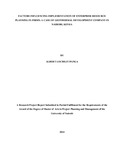| dc.description.abstract | Enterprise Resource Planning (ERP) systems have become common in large companies and
government corporations mainly in developed countries. Over the past three decades,
organizations worldwide facing pressure from changing business environments have adopted
sophisticated, off-shelf information technology applications rather than build their own
information technology systems in-house.While there is wide adoption of ERP systems in
Western economies, developing countries lag far behind. Implementation of the ERP systems
within organizations plays critical role in finance functions, human resource functions, supply
chain management functions and project management functions of organization because it
provides a platform for enhance deficiency and effectiveness in organization’s productivity. This
study sought to establish the factors influencing the implementation of Enterprise Resource
Planning in firms. The study was guided by the following objectives: To assess the influence of
end user training on the implementation of Enterprise Resource Planning in GDC; To establish
the influence of communication on the implementation of Enterprise Resource Planning in GDC;
To determine the influence of top management commitment on the implementation of Enterprise
Resource Planning in GDC and to find out the influence of organizational culture on the
implementation of Enterprise Resource Planning in GDC. Descriptive research design will be
used for the study. The target population consisted of 18 head of departments and employees of
GDC. The sample size was a total of 265 respondents. Questionnaires were used as instruments
for data collection. Questionnaires were used to collect data from the employees and the head of
departments. Data was analyzed through the use of a computer software SPSS. Primary data
from the field was edited first. Coding was then done to translate question responses into specific
categories. Coding was expected to organize and reduce research data into manageable
summaries. Quantitative data collected was analyzed by descriptive statistics while content
analysis techniques will be used to analyze qualitative data. Descriptive statistics such as means,
standard deviation, frequencies and percentages were used to describe the data. The analyzed
data was presented in form of tables. The study also revealed that the feedback from the User
Training was incorporated into the design and implementation of the ERP Modules. The study
also revealed that there was no a communication plan among the different departments on the
implementation of ERP. The study also revealed that that top management is necessary for
provision of leadership in the implementation of ERP to a large extent. Finally it further
established that organizational culture influences the implementation of ERP. The study
concluded that end-user training affects the implementation of ERP. The study further concluded
that failure to a communication plan among the departments affects the implementation of
ERP.The study further concluded that top management involvement influences the
implementation of Enterprise Resource Planning. It can finally be concluded that organizational
culture influences the implementation of Enterprise Resource Planning.Major recommendations
were end user training should be improved through organization workshops and seminars.
Adoption of effective communication channels to reduce resistance from the employees and
increase the implementation of ERP. Top management to increase their level of involvement and
also organization culture to be flexible to accommodate the adoption of Enterprise Resource
Planning. Areas for further research work included a study on the challenges facing the
implementation of ERP | en_US |

